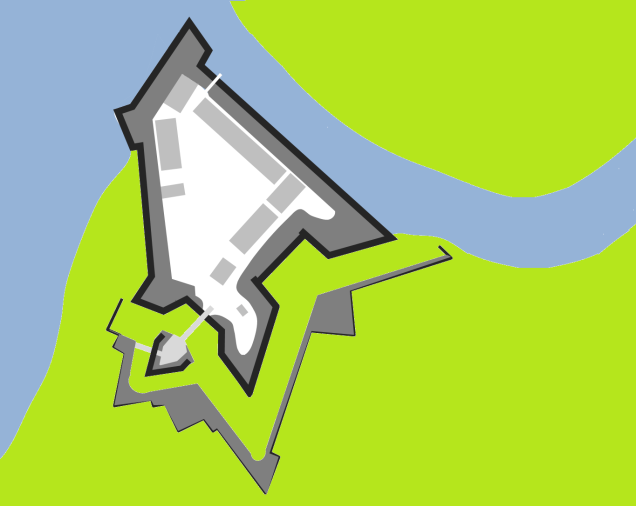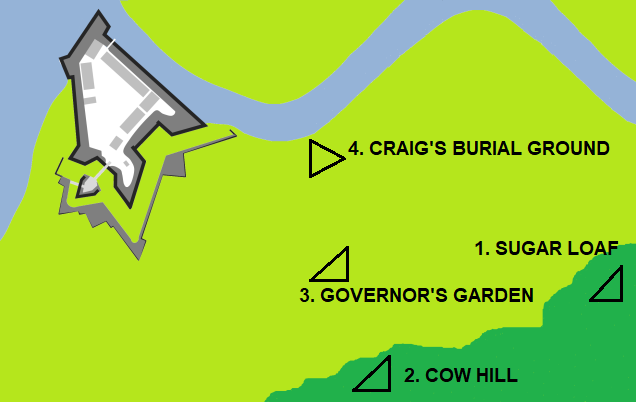Having captured both Fort George at Inverness and Fort Augustus, at the southern end of Loch Ness, the Jacobites moved on to the third Fort in the chain down the “Great Glen” formed by Loch Ness, Loch Lochy and Loch Linnhe. This was Fort William, which although constructed in a Vauban style was of a very irregular shape due to its position on the junction of Loch Linnhe and the River Nevis, as shown below.

I modelled this by using some of my standard PaperTerrain Vauban bastions, but with specially constructed wall sections joining them into this irregular shape, as below.

The two bastions to the right of the picture form a hornwork by being really close together. That will be useful in other scenarios.

The garrison of Fort William was commanded by Captain Scott of the 6th Foot and consisted of two companies of his own Regiment, two weak additional (ie recruiting) companies of the 21st Foot (Royal Scots Fusiliers), a few invalid Royal Artillery and three companies of Argyll Militia. I have shown some of the latter below. They are converted from Strelets Napoleonic Highlanders at rest. The garrison had a mixture of 6 pounder and 12 pounder cannons plus some smaller ¾ pounder swivel guns. You can see a couple of the latter covering the inner faces of the bastions below.

The Jacobite force began to arrive on 15th February 1746, but they were not ready to commence their siege until 15th March, since it took time for the heavy siege guns to be moved. This was not without mishap because some of the road had been washed away and one 8 pounder was overturned on the road running along Loch Ness.
The Jacobite force was commanded by Lieutenant Colonel Stapleton of the French Irish Regiment Berwick, with the Royal Ecossais, Irish Piquets, Cameron of Locheil’s Regiment, MacDonald of Keppoch’s Regiment and the Appin Stewart Regiment. The Jacobite artillery was initially commanded by Colonel Grante, but on 15th March he was injured by an almost spent shot from a swivel gun. The French Engineer Mirabelle de Gordon travelled down from Inverness to replace him.
Grante had planned to dig siege trenches, sapping forward towards Fort William, as he had commenced at Fort Augustus. Mirabelle de Gordon abandoned that plan and just built a series of gun batteries without enough protection.

The first battery was constructed on 20th March Sugar Loaf Hill, but it was to far away from the Fort to be effective, so a new battery was opened at the closer Cow Hill on 21st March. Although this was more effective, it was still not doing enough damage to Fort William. A new battery was opened at the Governor’s Garden on 27th March, but this was too exposed and the garrison of Fort William bombarded it with their artillery and mortars, causing damage to both the Jacobite guns and their ammunition supplies.
Finally on the night of 28/29th March the Jacobites opened up a battery on a low hill at Craig’s Burial Ground, less than 300 yards to the east of Fort William, as shown below.

On the evening of 31st March Captain Scott sent two of his companies in a sally to attack the Jacobite battery, just as they were changing guard.

Some guns were spiked (ie rendered useless) and other smaller guns and mortars were captured and taken back to Fort William. The Jacobites called off the siege on 3rd April and marched back to Inverness.
My next post will cover some of the smaller raids which took place during the Jacobite Rebellion.
Another ingenious build and interesting post. Thanks Rod. Today Is Donald Featherstone’s Centenary – how lucky you are to have played against him. https://manoftinblog.wordpress.com/2018/03/20/donald-featherstones-centenary/
LikeLiked by 1 person
Yes, Don was very inspirational back in those early days in the 1960s, but very modest with it. I saw him many years later (probably 1990s, but I can’t remember the exact date), when he invited me to a dining club which he had set up in Southampton of military history enthusiasts.
Best wishes
Rod
LikeLike
I thought your ‘about’ section in your website and pages featuring Donald Featherstone and your conversions (does this mould still work?) very interesting, https://rodwargaming.wordpress.com/about/
LikeLike
The mould has not been used for over 50 years, but I see no reason why it would still not work. Don made in in a rubber material, which does not seem to have deteriorated. I made some moulds for different figures (Napoleonic) myself in Plaster of Paris, but no longer have the moulds, nor the very amateur figures.
Best wishes
Rod
LikeLike
Reading one of Don’s BBC Radio talks that I have transcribed and passed to John Curry for the History of Wargaming Project, there is a great comic paragraph about Don garbling up in scarves, gauntlets etc (much to the amusement of his young family) to do his first plaster of Paris moulds, having heard about their explosive potential of still slightly damp. Nothing untoward happened. Not sure how 50 year old rubber will react to hot metal!
LikeLike
My wife would not thank me for experimenting with hot lead in our kitchen, so I think I will stick with 1:72 plastic figures which I have used for the past 50 years. There are so many different sets out there now.
Best wishes
Rod
LikeLike